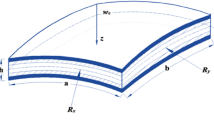Abstract
In this paper, a modified through hole-drilling method is developed to evaluate the effectiveness of the application of vibratory stress relief (VSR). The principal residual stresses at any specified point before and after the treatment of VSR are measured by this method with the same cemented commercially available three-element strain gauge rosette. By comparing the magnitude of the measured results, the effectiveness of the treatment of VSR can thus be determined. Thin butt-welded specimens are prepared to verify the accuracy of the modified hole-drilling method compared to that of the conventional hole-drilling method. The experimental results show that the percentages of the relative errors between these two methods are all within 2.9%. Therefore, this modified method shows good accuracy in the determination of residual stresses before and after VSR. Meanwhile, the maximum principal residual stresses at the measured points are effectively reduced by about 5.8% to 27% after the application of VSR, and the minimum principal residual stresses at the measured points are effectively reduced by about 9.6% to 31%.
Similar content being viewed by others
References
D. A. Hills, R. B. Waterhouse and B. Noble, “An analysis of shot peening”, Journal of Strain Analysis, 18(2), pp. 95–100, 1983.
V. S. Biront, V. A. Sushchikh, E. V. Yuzhakova, A. S. Fofanova and T. V. Baidina, “Relaxation of residual stresses in ultrasonic treatment”, Metal Science and Heat Treatment, 31(5), pp. 467–470, November 1989.
A. G. Olabi and M. S. J. Hashmi, “Stress relief procedures for low carbon steel (1020) welded components”, Journal of Materials Processing Technology, 56, pp. 552–562, 1996.
C. C. Weng and J. J. Chen, “Study on residual stress relief of welded structural steel joints”, Journal of Materials in Civil Engineering, 5(2), pp. 265–279, May 1993.
S. R. Rich, “Tried vibratory stress relief”, American Mechanist, pp. 110–111, April 1968.
S. Weiss, G. S. Baker and R. D. Das Gupta, “Vibrational residual stress relief in a plain carbon steel weldment”, Welding Research Supplement, pp 47-s–51-s, February 1976.
G. August and J. Hebel, “Subresonant vibrations relieve residual stress”, Metal Progress, pp. 51–55, November 1985.
G. P. Wonzney and G. R. Crawmer, “An investigation of vibrational stress relief in steel”, Welding Research Supplement, pp. 411-s–419-s, September 1968.
R. Dawson and D. G. Moffat, “Vibratory stress relief: a fundamental study of its effectiveness”, Transactions ASME, Journal of Engineering Materials and Technology, 102, pp. 169–176, April 1980.
B. B. Klauba and C. M. Adamas, “A progress on the use and understanding of vibratory stress relief”, Proceedings of the Winter Annual Meeting of the ASME, AMD 52, pp. 47–57, 1982.
C. Balasingh, M. R. Seshadri, M. N. Srinivasan and S. Ramaseshan, “Vibrational stress-relief of cast iron castings”, Indian Foundry Journal, pp. 129–136, November 1983.
E. P. Olenin, A. S. Averin, E. V. Dobrotina and O. K. Alekseev, “Reducing the residual stresses in welded components by vibrational method”, Welding Production, pp. 19–21, May 1983.
M. Jesensky, “Vibratory lowering of residual stresses in weldments”, Preceding of IIW Conference, Sofia, pp. 153–160, July 1987.
R. A. Claxton and A. Lupton, “Vibratory stress relieving of welded fabrications”, Welding and Metal Fabrications, pp. 541–544, December 1991.
C. A. Walker, A. J. Waddell and D. J. Johnston, “Vibratory stress relief — an investigation of the underlying processes”, Part E: Journal of Process Mechanical Engineering, 209, pp. 51–58, 1995.
C. Bouhelier, P. Barbarin, J. P. Deville and B. Miege, “Vibratory stress relief of welded parts”, Mechanical Relaxation of Residual Stress, ASTM STP 993, pp. 58–71, 1988.
R. D. Ohol, B. V. Nagendra Kumar and R. A. Noras, “Measurement of vibration-induced stress relief in the heavy fabrication industry”, Mechanical Relaxation of Residual Stress, ASTM STP 993, pp. 45–57, 1988.
G. S. Schajer, “Application of finite element calculations to residual stress measurements”, Transactions ASME, Journal of Engineering Materials and Technology, 103, pp. 157–163, April 1981.
N. J. Rendler and I. Vigness, “Hole-drilling strain-gage method of measuring residual stresses”, Experimental Mechanics, pp. 577–586, December 1966.
Bulletin TN-503-4, “Measurement of residual stresses by the hole-drilling strain gage method”, pp. 1–19, 1993.
ASTM-E837-92, “Standard test method for determining residual stress by the hole-drilling strain-gage method”, pp. 747–753, 1992.
M. Kabiri, “Nonuniform residual-stress measurement by hole-drilling method”, Experimental Mechanics, pp. 328–336, December 1984.
J. Y. Wang, “Refined analysis of the relieved strain coefficients for the off-center hole-drilling case”, Experimental Mechanics, pp. 367–371, December 1990.
M. T. Flaman, “Brief investigation of induced drilling stresses in the center-hole method of residual-stress measurement”, Experimental Mechanics, pp. 26–30, January 1982.
M. T. Flaman and J. A. Herring, “Comparison of four hole-producing techniques for the center-hole residual-stress measurement method”, Experimental Technique, pp. 30–32, 1985.
A. M. Nawwar and J. Shewchuk, “On the measurement of residual stress gradients in aluminum-alloy”, Experimental Mechanics, pp. 269–276, July 1978.
Author information
Authors and Affiliations
Corresponding author
Rights and permissions
About this article
Cite this article
Luh, G.C., Hwang, R.M. Evaluating the effectiveness of vibratory stress relief by a modified hole-drilling method. Int J Adv Manuf Technol 14, 815–823 (1998). https://doi.org/10.1007/BF01350766
Issue Date:
DOI: https://doi.org/10.1007/BF01350766




